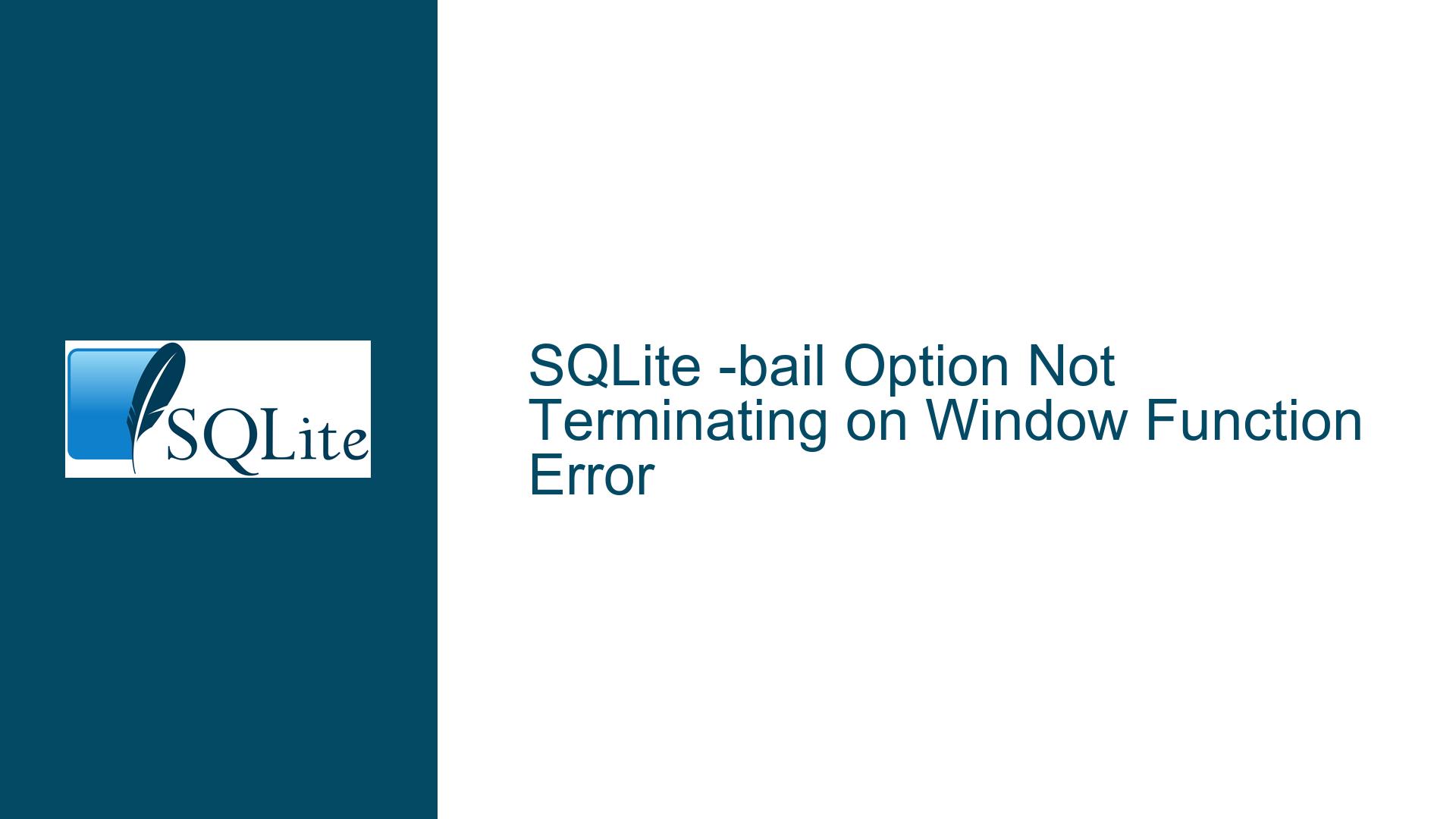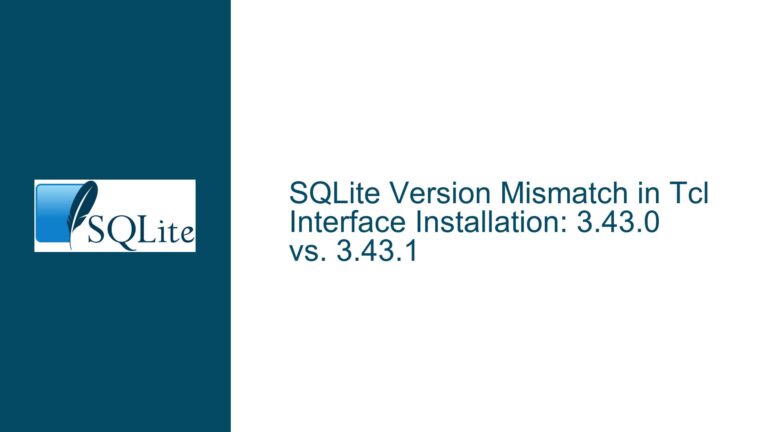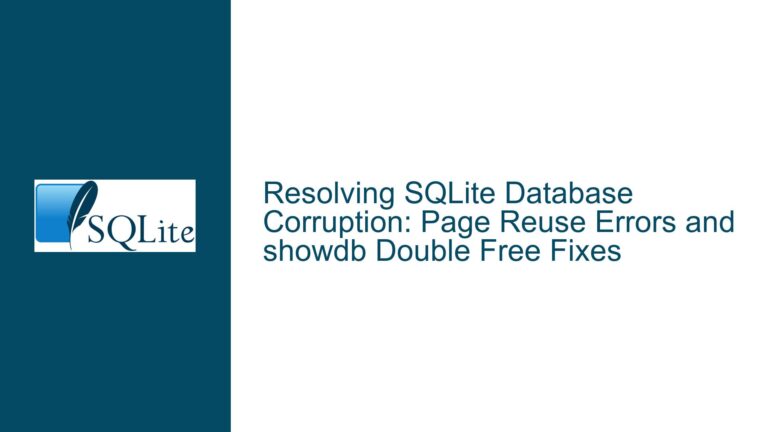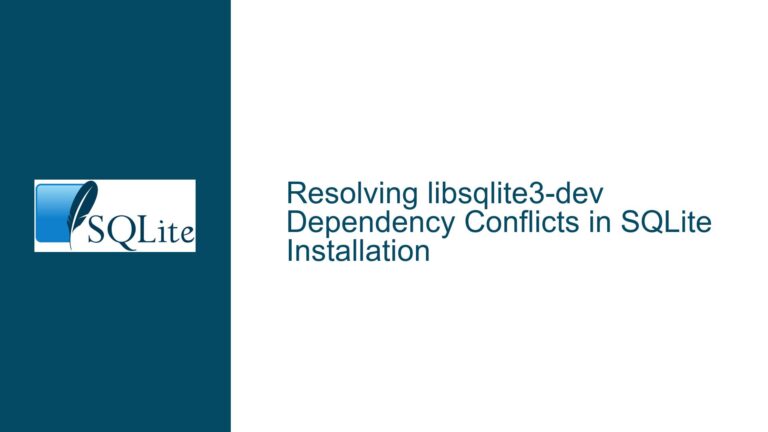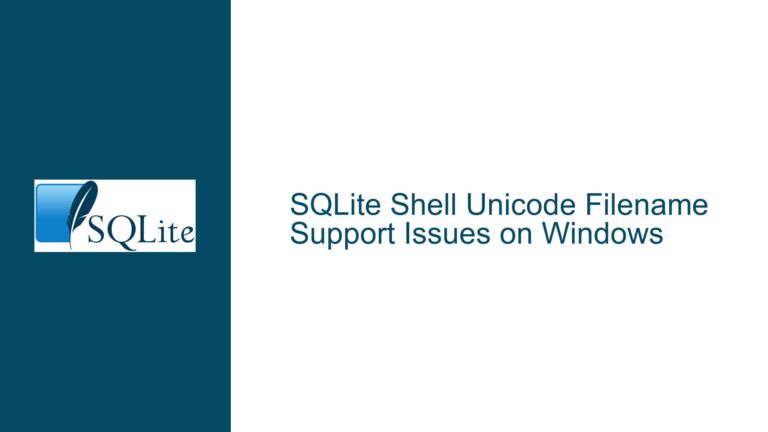SQLite -bail Option Not Terminating on Window Function Error
SQLite -bail Option Fails to Terminate on Window Function Misuse
The SQLite -bail option is designed to immediately terminate the SQLite shell when an error is encountered during the execution of SQL statements. This feature is particularly useful in scripting scenarios where the presence of an error should halt further processing to prevent unintended consequences. However, in the case of a specific SQL query involving a window function, the -bail option does not function as expected. The query in question attempts to use an aliased window function in an ORDER BY clause, which is not permitted by SQLite’s syntax rules. Despite the clear error message indicating the misuse of the aliased window function, the SQLite shell continues to execute rather than terminating as specified by the -bail option.
The query causing the issue is as follows:
DROP TABLE IF EXISTS t1;
CREATE TABLE t1(a INTEGER PRIMARY KEY, b CHAR(1), c CHAR(2), d ANY);
INSERT INTO t1 VALUES (10,'J', 'cc', NULL), (11,'K', 'cc', 'xyz'), (13,'M', 'cc', NULL);
SELECT sum(a) OVER (PARTITION BY c ORDER BY d ASC) AS xyz FROM t1 ORDER BY sum(xyz);
The error message generated is:
Error: near line 8: misuse of aliased window function xyz
This error is expected due to the misuse of the window function alias xyz in the ORDER BY clause. However, the SQLite shell does not terminate despite the presence of the -bail option.
Window Function Misuse and -bail Option Interaction
The core issue lies in the interaction between SQLite’s handling of window functions and the -bail option. Window functions in SQLite, such as SUM() OVER, allow for advanced analytical queries by performing calculations across a set of table rows that are related to the current row. However, SQLite imposes strict rules on how these functions can be used, particularly in clauses like ORDER BY. The misuse of an aliased window function in the ORDER BY clause is a syntax error, and SQLite correctly identifies this by throwing an error. However, the -bail option, which should terminate the shell upon encountering any error, fails to do so in this specific scenario.
The -bail option is implemented to ensure that any error, whether it is a syntax error, a constraint violation, or any other type of error, will cause the SQLite shell to exit immediately. This behavior is crucial in automated environments where errors need to be handled promptly to avoid cascading failures. The failure of the -bail option to terminate the shell in this case suggests a potential issue with how SQLite processes errors related to window functions.
One possible explanation is that the error generated by the misuse of the window function is not being correctly classified as a fatal error by the SQLite shell. The -bail option may be designed to respond only to certain types of errors, and window function misuse might not be included in this category. Alternatively, there could be a bug in the error handling logic that prevents the -bail option from recognizing this specific error as a terminating condition.
Recompiling SQLite with Latest Prerelease Snapshot
To address this issue, the recommended course of action is to recompile SQLite using the latest prerelease snapshot. SQLite is under active development, and many issues, including those related to error handling and the -bail option, are regularly addressed in new releases. The prerelease snapshot contains the most recent fixes and improvements, and it is possible that the issue with the -bail option and window function misuse has already been resolved.
Recompiling SQLite involves downloading the latest source code from the official SQLite website, configuring the build environment, and compiling the code using a C compiler such as GCC or Clang. The process typically involves the following steps:
- Download the Source Code: Obtain the latest prerelease snapshot from the SQLite download page.
- Extract the Source Code: Unpack the downloaded archive to a directory on your system.
- Configure the Build: Run the
configurescript to set up the build environment. This step may involve specifying options such as the installation directory and enabling or disabling certain features. - Compile the Code: Use the
makecommand to compile the SQLite source code. This step will generate the SQLite shell executable and other necessary binaries. - Install the Binaries: Optionally, use the
make installcommand to install the compiled binaries to the specified installation directory.
After recompiling SQLite, it is important to retest the problematic query to determine if the issue with the -bail option has been resolved. If the problem persists, further investigation may be required, including examining the SQLite source code to understand how the -bail option interacts with error handling for window functions.
In conclusion, the failure of the -bail option to terminate the SQLite shell on a window function misuse error is a significant issue that can impact automated scripting and error handling. Recompiling SQLite with the latest prerelease snapshot is a recommended first step in resolving this issue. If the problem persists, further analysis of the SQLite source code and error handling logic may be necessary to identify and fix the underlying cause.
